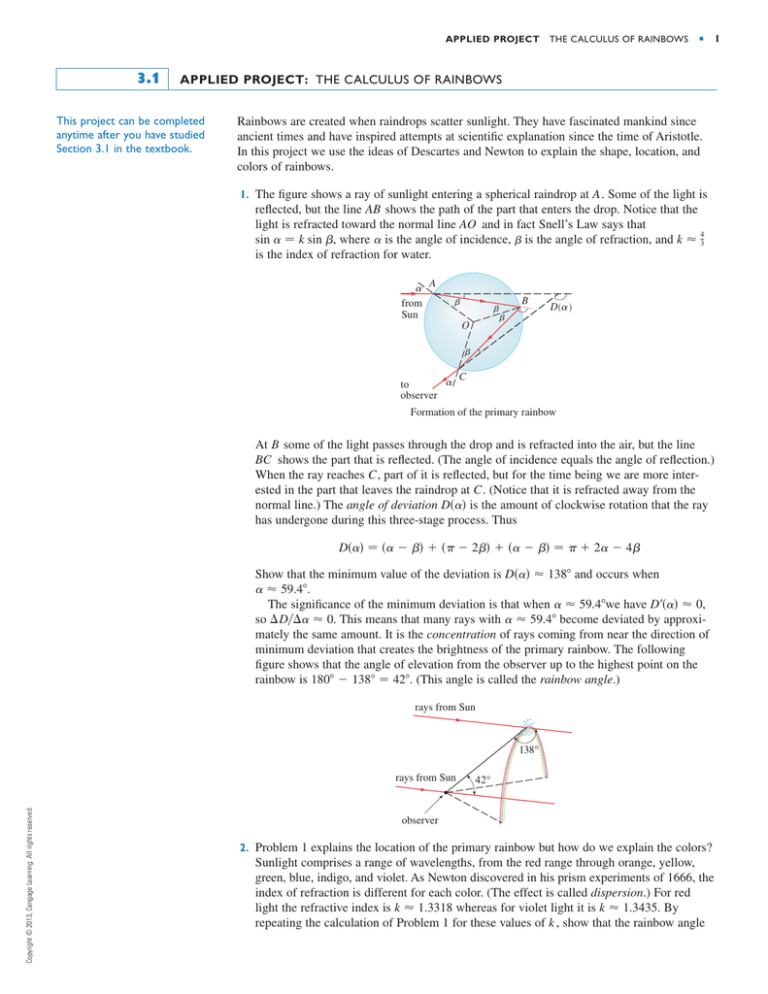
APPLIED PROJECT
3.1
THE CALCULUS OF RAINBOWS
■
1
APPLIED PROJECT: THE CALCULUS OF RAINBOWS
This project can be completed
anytime after you have studied
Section 3.1 in the textbook.
Rainbows are created when raindrops scatter sunlight. They have fascinated mankind since
ancient times and have inspired attempts at scientific explanation since the time of Aristotle.
In this project we use the ideas of Descartes and Newton to explain the shape, location, and
colors of rainbows.
1. The figure shows a ray of sunlight entering a spherical raindrop at A . Some of the light is
reflected, but the line AB shows the path of the part that enters the drop. Notice that the
light is refracted toward the normal line AO and in fact Snell’s Law says that
sin ␣ 苷 k sin , where ␣ is the angle of incidence,  is the angle of refraction, and k ⬇ 43
is the index of refraction for water.
å A
from
Sun
∫
B
∫
D(å )
∫
O
∫
å
to
observer
C
Formation of the primary rainbow
At B some of the light passes through the drop and is refracted into the air, but the line
BC shows the part that is reflected. (The angle of incidence equals the angle of reflection.)
When the ray reaches C , part of it is reflected, but for the time being we are more interested in the part that leaves the raindrop at C . (Notice that it is refracted away from the
normal line.) The angle of deviation D共␣兲 is the amount of clockwise rotation that the ray
has undergone during this three-stage process. Thus
D共␣兲 苷 共␣ ⫺ 兲 ⫹ 共 ⫺ 2兲 ⫹ 共␣ ⫺ 兲 苷 ⫹ 2␣ ⫺ 4
Show that the minimum value of the deviation is D共␣兲 ⬇ 138⬚ and occurs when
␣ ⬇ 59.4⬚.
The significance of the minimum deviation is that when ␣ ⬇ 59.4⬚we have D⬘共␣兲 ⬇ 0,
so ⌬D兾⌬␣ ⬇ 0. This means that many rays with ␣ ⬇ 59.4⬚ become deviated by approximately the same amount. It is the concentration of rays coming from near the direction of
minimum deviation that creates the brightness of the primary rainbow. The following
figure shows that the angle of elevation from the observer up to the highest point on the
rainbow is 180⬚ ⫺ 138⬚ 苷 42⬚. (This angle is called the rainbow angle.)
rays from Sun
138°
Copyright © 2013, Cengage Learning. All rights reserved.
rays from Sun
42°
observer
2. Problem 1 explains the location of the primary rainbow but how do we explain the colors?
Sunlight comprises a range of wavelengths, from the red range through orange, yellow,
green, blue, indigo, and violet. As Newton discovered in his prism experiments of 1666, the
index of refraction is different for each color. (The effect is called dispersion.) For red
light the refractive index is k ⬇ 1.3318 whereas for violet light it is k ⬇ 1.3435. By
repeating the calculation of Problem 1 for these values of k , show that the rainbow angle
2
■
APPLIED PROJECT
THE CALCULUS OF RAINBOWS
is about 42.3⬚ for the red bow and 40.6⬚ for the violet bow. So the rainbow really consists
of seven individual bows corresponding to the seven colors.
C
∫
D
3. Perhaps you have seen a fainter secondary rainbow above the primary bow. That results
∫
from the part of a ray that enters a raindrop and is refracted at A , reflected twice (at B and
C ), and refracted as it leaves the drop at D . (See the figure at the left.) This time the deviation angle D共␣兲 is the total amount of counterclockwise rotation that the ray undergoes in
this four-stage process. Show that
∫
å
to
observer
∫
from
Sun
∫
å
∫
A
D共␣兲 苷 2␣ ⫺ 6 ⫹ 2
B
and D共␣兲 has a minimum value when
Formation of the secondary rainbow
cos ␣ 苷
冑
k2 ⫺ 1
8
Taking k 苷 43 , show that the minimum deviation is about 129⬚ and so the rainbow angle
for the secondary rainbow is about 51⬚, as shown in the following figure.
42° 51°
4. Show that the colors in the secondary rainbow appear in the opposite order from those in
Copyright © 2013, Cengage Learning. All rights reserved.
the primary rainbow.
APPLIED PROJECT
THE CALCULUS OF RAINBOWS
SOLUTIONS
1. From Snell’s Law, we have sin α = k sin β ≈ 43 sin β ⇔ β ≈ arcsin 34 sin α . We substitute this into
D(α) = π + 2α − 4β = π + 2α − 4 arcsin 34 sin α , and then differentiate to find the minimum:
k
2 l−1/2 3
3 cos α
3 cos α
t
D0 (α) = 2 − 4 1 − 34 sin α
. This is 0 when t
=2 ⇔
4 cos α = 2 −
9
9
2
1 − 16 sin α
1 − 16
sin2 α
t
9
9
9
7
7
cos2 α = 1 − 16
sin2 α ⇔ 94 cos2 α = 1 − 16
cos2 α = 16
⇔ cos α = 27
⇔
1 − cos2 α ⇔ 27
4
16
t
7
≈ 59.4◦ , and so the local minimum is D(59.4◦ ) ≈ 2.4 radians ≈ 138◦ .
α = arccos 27
To see that this is an absolute minimum, we check the endpoints, which in this case are α = 0 and α = π2 :
D(0) = π radians = 180◦ , and D π2 ≈ 166◦ .
dβ
3 cos α
dβ
dβ
: sin α = 43 sin β ⇔ cos α = 43 cos β
⇔
=
, so since
Another method: We first calculate
dα
dα
dα
4 cos β
dβ
1
dβ
D0 (α) = 2 − 4
=0 ⇔
= , the minimum occurs when 3 cos α = 2 cos β. Now we square both sides
dα
dα
2
and substitute sin α = 43 sin β, leading to the same result.
1
2. If we repeat Problem 1 with k in place of 43 , we get D(α) = π + 2α − 4 arcsin
sin α
⇒
k
v
2
4 cos α
2 cos α
sin α
0
, which is 0 when
⇔
D (α) = 2 − t
= 1−
k
k
k 1 − [(sin α)/k]2
2
2
sin α
2 cos α
=1−
⇔ 4 cos2 α = k2 − sin2 α ⇔ 3 cos2 α = k2 − 1 ⇔
k
k
u
k2 − 1
α = arccos
. So for k ≈ 1.3318 (red light) the minimum occurs at α1 ≈ 1.038 radians, and so the
3
rainbow angle is about π − D(α1 ) ≈ 42.3◦ . For k ≈ 1.3435 (violet light) the minimum occurs at
α2 ≈ 1.026 radians, and so the rainbow angle is about π − D(α2 ) ≈ 40.6◦ .
dβ
cos α
dβ
, and then substitute
=
.
Another method: As in Problem 1, we can instead find D0 (α) in terms of
dα
dα
k cos β
3. At each reflection or refraction, the light is bent in a counterclockwise direction: the bend at A is α − β, the bend
at B is π − 2β, the bend at C is again π − 2β, and the bend at D is α − β. So the total bend is
sin α
D(α) = 2(α − β) + 2(π − 2β) = 2α − 6β + 2π, as required. We substitute β = arcsin
and differentiate,
k
v
2
6 cos α
3 cos α
sin α
0
, which is 0 when
⇔
to get D (α) = 2 − t
= 1−
k
k
k 1 − [(sin α)/k]2
9 cos2 α = k2 − sin2 α ⇔
Copyright © 2013, Cengage Learning. All rights reserved.
t
8 cos2 α = k2 − 1 ⇔ cos α = 18 (k2 − 1). If k = 43 , then the minimum occurs at
u
(4/3)2 − 1
α1 = arccos
≈ 1.254 radians. Thus, the minimum
8
counterclockwise rotation is D(α1 ) ≈ 231◦ , which is equivalent to a
clockwise rotation of 360◦ − 231◦ = 129◦ (see the figure). So the rainbow
angle for the secondary rainbow is about 180◦ − 129◦ = 51◦ , as required.
In general, the rainbow angle for the secondary rainbow is
π − [2π − D(α)] = D(α) − π.
■
3
4
■
APPLIED PROJECT
THE CALCULUS OF RAINBOWS
4. In the primary rainbow, the rainbow angle gets smaller as k gets larger, as we found in Problem 2, so the colors
appear from top to bottom in order of increasing k. But in the secondary rainbow, the rainbow angle gets larger as k
gets larger. To see this, we find the minimum deviations for red light and for violet light in the secondary
u
1.33182 − 1
rainbow. For k ≈ 1.3318 (red light) the minimum occurs at α1 ≈ arccos
≈ 1.255 radians, and so
8
the rainbow angle is D(α1 ) − π ≈ 50.6◦ . For k ≈ 1.3435 (violet light) the minimum occurs at
u
1.34352 − 1
≈ 1.248 radians, and so the rainbow angle is D(α2 ) − π ≈ 53.6◦ . Consequently, the
α2 ≈ arccos
8
rainbow angle is larger for colors with higher indices of refraction, and the colors appear from bottom to top in order
of increasing k, the reverse of their order in the primary rainbow.
Note that our calculations above also explain why the secondary rainbow is more spread out than the primary
rainbow: in the primary rainbow, the difference between rainbow angles for red and violet light is about 1.7◦ ,
Copyright © 2013, Cengage Learning. All rights reserved.
whereas in the secondary rainbow it is about 3◦ .




